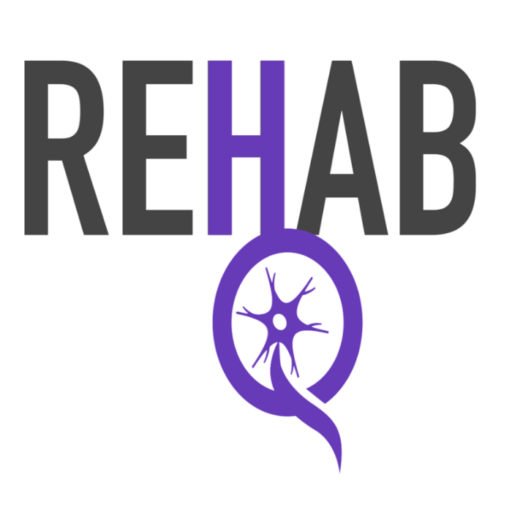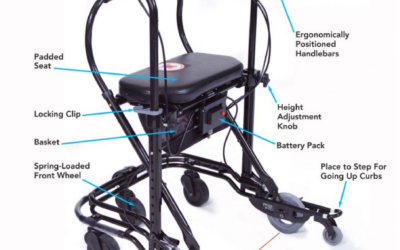A step stool with a handle is one of the most seems like an odd piece of “rehab equipment”, however, it is truly “worth its weight in gold”. It is probably the one itemI can honestly say I use multiple times a day in my clinic. And, rarely as an actual step stool. Although, I am not the tallest tree in the forest so it does come in handy for use as an actual step stool as well ?
But, back to the “non-step-stool” uses……..
1. Putting on a brace or shoes

Putting you foot up on a step stool serves two purposes. Obviously, it does bring the foot closer to you so to make it easier to reach. I know, not really “ground breaking” information. ??♀️But the other thing it does is that it bends your knee and you hip MORE than 90 degrees. And this is critical, especially if you have spasticity in your ankle. The more the knee and the hip are bent, the less likely the foot is susceptible to go into that involuntary pointing. If you have this, you know what a pain in the behind this can be. If you are a caregiver, you know as well. It can be near impossible. And the more you try and bend the ankle, the more it wants to do just the opposite.
So, long story short, get a step stool and save the unintentional “morning workout” trying to get your shoes on. ?
2. A step stool helps with sit to stand and standing balance

Anytime I am teaching a patient to stand up from a chair (correctly ?), I start with the step stool. The reason is, one MAJOR problem is that many people who struggle to stand up from a chair rely on “pulling up” with their arms. That can include pulling up by grabbing on to a family member, piece of furniture, car door, grab bar, door frame…..you name it. I have seen it. Unfortunately, this is a bad habit to get into and one of the first habits I try and “re-direct”.
So, what in the world does a step stool do to correct this? As you can see in the picture, holding on to the handle with the step pointing away does not allow you to pull on the handle. Well, you can, but you probably are not going to get very far ?A little (of what I call) physical therapy “trickery”
Wait!
Before you start calling me all versions of “PT = physical torturer” names, the step stool is ALSO helping you. By design and the laws of physics (man, I love physics), the stool IS giving you a very stable structure. To benefit from this “stable structure” (the step stool with the step pointing away)…… you need to lean forward. ?Yup, you can still use your arms to assist.
And, it is training your brain to position the heaviest part of your body over your feet.
3. A step stool is lightweight and easily mobile
A step stool with a handle is also great to have next to you whenever you need to stand. It is at a good height to hold onto for added support. Compared to a cane, it will stay upright and won’t tip over when you let go. And compared to a walker, it is small and can stay on the side of you. This is helpful in a close or a bathroom where space might be limited.
4. A step stool is great for stretching

If you are someone who needs to stretch your ankles,
The stool is perfect for that. The handle is at a good height to hold onto. Additionally, the benefit of being able to lean forward (slightly), helps to “deepen the stretch”.
So, in summary, a step stool is not only for the “height challenged” ??♀️. It IS one of the most underutilized and most valuable tool in your rehab “bag of tricks”.
Tip for the therapist: The bariatric step stool is much better. It has a wider base and is sturdier than a standard step stool with a handle.
Equipment for Stroke Arm Exercises
Products For a Spastic Arm Having the right tools for stroke arm rehabilitation is critical. Especially for those who have spasticity. Spasticity is an involuntary muscle contraction caused by damage to the brain and/or spinal cord. In the arm it can cause...
Foam Wedges: For positioning and more
Positioning/Stretching Foam Wedge This wedge is made of dense foam with a rubber base to keep it from sliding. Uses: It can be used to position the pelvis. It can be placed under the thigh in sitting to stop the leg from rotating outward. It can be used for bridging...
Complete Guide to Buying a Wheelchair Cushion
Wheelchairs are an extremely valuable piece of equipment during the neurologic recovery process. They provide a means of getting around when walking is not safe and/or is not possible. However, they also come with the risk of developing pressure ulcers. Pressure...
Product Spotlight: This tool improves trunk alignment
Better posture means better arm rehabilitation. Period. Said another way, proper trunk alignment is essential for efficient arm movement. However, in most cases, hemiparesis (weakness on one side of the body), paraparesis (weakness on the lower half of the body), and...
Product Spotlight: Best Gait Belt to Improve Standing
A gait belt can be a critical tool to help a loved one relearn the correct way to stand. With the right gait belt, you can also help someone walk in the early stages of neurologic rehab. And that is why gait belts made its way to our latest "product spotlight"....
Product Spotlight: Stroke Arm Exercise for Spasticity
Spasticity and abnormal movement patterns can make it difficult to perform stroke arm exercise. The Urias air splint can be an invaluable tool to minimize involuntary arm contractions, reduce pain, prevent contractures, and make it one thousand times easier to manage...
Product Spotlight: #1 Walker for Parkinson’s Disease
What is the best walker for Parkinson's disease (PD)? Maybe you are not there yet. Maybe you are hesitant to even approach the idea of a walker. Well, I have you covered. After nearly 20 years of working with people living with PD, I know how you might be feeling. The...








